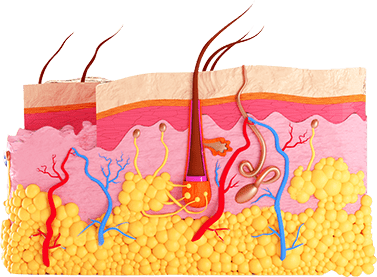DNA test for genetic predisposition to melanoma
Melanoma is a dangerous tumorous disease affecting the skin and sometimes the retina and mucous membranes. This is a malignant tumor distinguished by its propensity to spread and metastasize.
by e-mail (anytime):
 EN | USD
EN | USD
by e-mail (anytime):
Melanoma is a dangerous tumorous disease affecting the skin and sometimes the retina and mucous membranes. This is a malignant tumor distinguished by its propensity to spread and metastasize.


Melanoma accounts for 1% of all cancer cases and 10% of all malignant skin tumors. Melanoma is the most common cause of death from skin cancer: nearly 80% of all fatalities in this patient group are related to this dangerous disease.
The incidence of melanoma worldwide is progressively increasing, and this is particularly pronounced in countries with a hot climate and a large annual number of clear, sunny days. The widespread adoption of techniques for the early diagnosis of melanoma in patients in the at-risk group is bringing down the frequency with which neglected forms are identified, and improving the survivability rate.
Melanoma is formed of melanocytes, which are a particular type of cell that synthesizes the pigment melanin. Under the effect of a number of adverse factors, mutations occur in the melanocytes, leading to uncontrolled division of the cells, which spread and form the primary tumor site.
The cause of the malignant transformation of the melanocytes is not definitively known, but the particular significance of ultra-violet radiation is well established. The more often someone is exposed to direct sunlight and receives sunburn, the higher their likelihood of developing melanoma. It is probably solar radiation in particular that triggers the cancerous mutations.
The risk factors for melanoma include:
In order to predict the risk of the disease, it is important to determine the skin phototype. Phototypes I and II – people with pale skin, light-colored eyes and fair or red hair – are the most sensitive to ultra-violet and hence have the highest risk of melanoma. The skin of these first two phototypes burns extremely quickly and almost never tans, or tans only weakly. People with phototypes III and IV develop melanoma less frequently: they have brown eyes and brown hair (from light brown to nearly black), and fair or slightly dark skin that tans well and may burn. The disease is diagnosed least frequently in people of phototypes V and VI: they have ‘black’ eyes and black hair, and their skin is very brown or black, and practically never gets sunburned.
Despite the established link between skin phototype, intensity of solar radiation and the risk of melanoma, it is still not known why this cancer does not affect everybody with white skin who regularly suffers ultraviolet burns. It may be related to a hereditary predisposition to the disease.
Many of the risk factors for melanoma are genetically determined. For example, the skin phototype and the number and type of birthmarks a person has are determined by their genotype and acquired at birth (or appear in the first months of life).
The risk of melanoma is significantly higher for people with relatives who have the disease, or who have had it, than for the population at large: for this group, the figure is 15%. Patients with a first diagnosis of melanoma who have a problematic family history typically have an early onset of the disease, a large number of pre-existing nevi, and multiple initial tumor sites (several primary melanomas identified).
CDKN2A, one of the genes that code for a high risk of melanoma, is classed as an immunosuppressor. The mutation suppresses the antineoplastic immune response, masking the pathologically changed melanocytes and their rapid multiplication. The CDKN2A gene is found on chromosome 9 and is present in nearly 1/3 of melanoma patients. The presence of the MC1R gene and certain other genetic structures is also evidence of genetic predisposition to melanoma.
Any of the following changes in a pigmented nevus may be signs of a melanoma forming on it:
Increased size, including growth in any one direction with the formation of rays;
Hardening;
Change of shape and intensity of coloration;
Red patches around the birthmark;
Small «invasions» of pigment a short distance from the nevus;
Lesions or scabs;
Heightened sensitivity and bleeding from the birthmark;
Itching or burning sensation in the area of the nevus.
The diagnosis is confirmed by means of a biopsy of the primary site and regional lymph nodes, followed by a histological examination of the material. As injury to the tumor site is highly undesirable, the best option is a biopsy combined with an operation to remove the melanoma.
A sentinel lymph node biopsy is a modern technique for diagnosing lymph node damage. Special markers (stains and radioisotopes) are used to identify the lymph nodes that lymph from the tumor is entering first. The sentinel lymph nodes thus identified are sent for microscopic analysis, and the result helps decide on tactics for further treatment.
Millions of melanoma patients spent hundreds of thousands of dollars on treatment, often when it is too late to think of a cure and the treatment aims only to prolong life.
Protect your health and take care of your loved ones! Take a DNA test for genetic predisposition to melanoma.

Melanoma can have a variety of visual and microscopic characteristics.
Five basic types of skin melanoma are distinguished:
Superficial spreading melanoma:
the most frequently seen form, diagnosed in 65% of cases. This type of melanoma has a relatively favorable prognosis: in many cases, timely treatment makes it possible to prevent recurrence and metastasis.
Nodular melanoma:
rapidly penetrates into the thickness of the skin, forming a nodule. Difficult to treat radically.
Acral lentiginous melanoma (subungual or nail melanoma):
affects the nail bed, fingertips and palms. Most often encountered in black people.
Lentigo maligna melanoma:
forms on the site of a birthmark. Its favorite location is the skin of the face. Grows widthwise without growing down into the lower layers of the skin. Characterized by its relatively favorable course.
Achromatic melanoma:
has no dark coloration and is very rarely encountered.
The stage of the melanoma gives an idea of the course of the disease and its prognosis. For stage 1, five-year survivability is as high as 95%; for stage 2, it is about 70%; for stage 3, no higher than 35-40%. In patients with final-stage melanoma, the survival rate is extremely low, no higher than 5%.
The main treatment for melanoma is surgical excision of the tumor. The ideal surgical option for melanoma is a radical operation involving the complete removal of all atypical cancer cells.
is carried out with the obligatory capture of healthy tissues. Modern technologies of intraoperative histological examination (Mos method) make it possible to minimize the exeresis of healthy tissues with a high impact of the operation. To prevent the dispersion of tumor cells, the operation is often performed with a laser knife or electrosurgical unit.
- is a prerequisite for the effectiveness of melanoma treatment. Total phylactic removal of all lymph nodes is currently not considered appropriate. The best option is an operation performed according to the results of a biopsy of sentinel lymph nodes.
indicates the impossibility of radical operation. Nevertheless, palliative surgery aimed at improving life quality may be indicated for such patients.
Stage III and IV melanomas are treated with agents known as monoclonal antibodies, which trigger the body’s own antineoplastic action and have a targeted effect. The selectivity of the action of these agents is what makes this treatment more bearable for the patient.
The latest biological therapy, using TIL cells, is applied in the treatment of melanoma. T lymphocytes, which have the greatest antineoplastic effect, are taken from the patient’s body. The T cells are multiplied in a special laboratory, and then, after 2-3 weeks, they are reintroduced into the patient’s body. TIL therapy is usually carried out in cases of inoperable melanoma, and it yields quite good results: the primary site shrinks, metastatic sites regress, and the quality and duration of patients’ lives is improved.
This is used rarely, and mainly to relieve the condition of patients with metastases in the bone tissue.
Prevention of melanoma is based on protection from the rays of the sun. This advice is especially relevant to people with pale skin that burns quickly. To this end, it is important to use UV-filtering sunscreen and sunglasses and to avoid sunburn and intense, dark tanning.
It should be borne in mind that melanoma can be cured only in the earliest stages, making it vitally important to carefully watch the condition of birthmarks on the body. Any change in a nevus, however slight, should prompt a visit to an onco-dermatologist.
Melanoma is difficult to diagnose in the initial stage because of the inconspicuousness of the symptoms: a gradual change of size and shape is not at all immediately obvious. Modern clinics therefore use the technique of nevus mapping, a digital log of all birthmarks indicating their measurements and location. This approach makes it possible to trace the slightest changes in size, shape, or color of the nevus, and to take appropriate measures in good time.
A DNA test is the only way of identifying a genetic predisposition to melanoma. The results of the analysis are valuable diagnostic material that can be used to design an optimally effective prevention plan and screening schedule.
Don’t wait for malignant cancer to spread – the consequences could be serious, and there may be no possibility of a complete cure. Take a DNA test for genetic predisposition to melanoma, and start prevention as early as you can!
